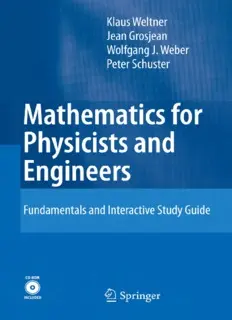Table Of Content· ·
Klaus Weltner Wolfgang J. Weber Jean Grosjean
Peter Schuster
Mathematics for Physicists
and Engineers
Fundamentals and Interactive Study Guide
1 3
Prof.Dr.KlausWeltner WolfgangJ.Weber
UniversityofFrankfurt UniversityofFrankfurt
InstituteforDidacticofPhysics ComputingCenter
Max-von-Laue-Straße1 Grüneburgplatz1
60438Frankfurt/Main 60323Frankfurt
Germany Germany
[email protected] [email protected]
Dr.PeterSchuster Prof.Dr.JeanGrosjean
AmHolzweg30 SchoolofEngineering
65843Sulzbach attheUniversityofBath
Germany England
ThistitlewasoriginallypublishedbyStanleyThornes(Publisher)Ltd,1986,entitled‘Mathematicsfor
EngineersandScientists’byK.Weltner,J.Grosjean,F.SchusterandW.J.Weber.
CartoonsinthestudyguidebyMartinWeltner.
ISBN 978-3-642-00172-7 e-ISBN 978-3-642-00173-4
DOI 10.1007/978-3-642-00173-4
SpringerDordrechtHeidelbergLondonNewYork
LibraryofCongressControlNumber:2009928636
©Springer-VerlagBerlinHeidelberg2009
Thisworkissubjecttocopyright.Allrightsarereserved,whetherthewholeorpartofthematerialis
concerned,specificallytherightsoftranslation,reprinting,reuseofillustrations,recitation,broadcasting,
reproductiononmicrofilmorinanyotherway,andstorageindatabanks.Duplicationofthispublication
orpartsthereofispermittedonlyundertheprovisionsoftheGermanCopyrightLawofSeptember9,
1965,initscurrentversion,andpermissionforusemustalwaysbeobtainedfromSpringer.Violations
areliabletoprosecutionundertheGermanCopyrightLaw.
Theuseofgeneral descriptive names, registered names, trademarks, etc. inthis publication does not
imply,evenintheabsenceofaspecificstatement,thatsuchnamesareexemptfromtherelevantprotective
lawsandregulationsandthereforefreeforgeneraluse.
Thepublisherandtheauthorsacceptnolegalresponsibilityforanydamagecausedbyimproperuseof
theinstructionsandprogramscontainedinthisbookandtheCD.Althoughthesoftwarehasbeentested
withextremecare,errorsinthesoftwarecannotbeexcluded.
TypesettingandProduction:le-texpublishingservicesGmbH,Leipzig,Germany
Coverdesign:eStudioCalamarS.L.,Spain/Germany
Printedonacid-freepaper
SpringerispartofSpringerScience+BusinessMedia(www.springer.com)
Main Authors of the International Version
Prof. Dr. Klaus Weltner has studied physicsat the TechnicalUniversityHannover
(Germany)andtheUniversityofBristol(England).Hegraduatedinplasmaphysics
andwasprofessorofphysicsanddidacticofphysicsattheuniversitiesOsnabrück,
Berlin,FrankfurtandvisitingprofessorofphysicsattheFederalUniversityofBahia
(Brazil).
Prof.Dr.JeanGrosjeanwasHeadofAppliedMechanicsattheSchoolofEngineer-
ingattheUniversityofBath(England).
Wolfgang J. Weber has studied mathematics at the universities of Frankfurt(Ger-
many), Oxford (England) and Michigan State (USA). He is currently responsible
forthetrainingofcomputerspecialistsatthecomputingcenterattheUniversityof
Frankfurt.
Dr.-Ing.PeterSchusterwaslecturerattheSchoolofEngineeringattheUniversity
ofBath(England).Differentappointmentsinthechemicalindustry.
v
Preface
Mathematicsis an essential tool for physicistsand engineerswhich students must
usefromtheverybeginningoftheirstudies.Thiscombinationoftextbookandstudy
guideaimstodevelopasrapidlyaspossiblethestudents’abilitytounderstandand
tousethosepartsofmathematicswhichtheywillmostfrequentlyencounter.Thus
functions,vectors,calculus,differentialequationsandfunctionsofseveralvariables
are presented in a very accessible way. Further chapters in the book provide the
basicknowledgeonvariousimportanttopicsinappliedmathematics.
Basedontheirextensiveexperienceaslecturers,eachoftheauthorshasacquired
acloseawarenessoftheneedsoffirst-andsecond-yearsstudents.Oneoftheiraims
hasbeentohelpuserstotacklesuccessfullythedifficultieswithmathematicswhich
are commonly met. A special feature which extends the supportive value of the
maintextbookistheaccompanying“studyguide”.Thisstudyguideaimstosatisfy
twoobjectivessimultaneously:itenablesstudentstomakemoreeffectiveuseofthe
maintextbook,anditoffersadviceandtrainingontheimprovementoftechniques
onthestudyoftextbooksgenerally.
Thestudyguidedividesthewholelearningtaskintosmallunitswhichthestu-
dentisverylikelytomastersuccessfully.Thusheorsheisaskedtoreadandstudy
alimitedsectionofthetextbookandtoreturntothestudyguideafterwards.Learn-
ingresultsarecontrolled,monitoredanddeepenedbygradedquestions,exercises,
repetitionsandfinallybyproblemsandapplicationsofthecontentstudied.Sincethe
degreeofdifficultiesisslowlyrisingthestudentsgainconfidenceimmediatelyand
experiencetheir own progressin mathematicalcompetencethus fosteringmotiva-
tion.Incaseoflearningdifficultiesheorsheisgivenadditionalexplanationsandin
caseofindividualneedssupplementaryexercisesandapplications.Sothesequence
of the studiesis individualisedaccordingto the individualperformanceand needs
andcanberegardedasafulltutorialcourse.
TheworkwasoriginallypublishedinGermanyunderthetitle“Mathematikfür
Physiker” (Mathematics for physicists). It has proved its worth in years of actual
use. This new international version has been modified and extended to meet the
needsofstudentsinphysicsandengineering.
vii
viii Preface
TheCDofferstwoversions.Inafirstversiontheframesofthestudyguideare
presentedonaPCscreen.Inthiscasetheuserfollowstheinstructionsgivenonthe
screen,atfirststudyingsectionsofthetextbookoffthePC.Afterthisautonomous
studyheistoanswerquestionsandtosolveproblemspresentedbythePC.Asecond
versionisgivenaspdffilesforstudentspreferringtoworkwithaprintversion.
Both the textbook and the study guide have resulted from teamwork. The au-
thors of the original textbook and study guides were Prof. Dr. Weltner, Prof.
Dr. P.-B. Heinrich, Prof. Dr. H. Wiesner, P. Engelhard and Prof. Dr. H. Schmidt.
Thetranslationandtheadaptionwasundertakenbytheundersigned.
Frankfurt,August2009 K.Weltner
J.Grosjean
P.Schuster
W.J.Weber
Acknowledgement
OriginallypublishedintheFederalRepublicofGermanyunderthetitle
MathematikfürPhysiker
bytheauthors
K.Weltner,H.Wiesner,P.-B.Heinrich,P.EngelhardtandH.Schmidt.
TheworkhasbeentranslatedbyJ.GrosjeanandP.Schusterandadaptedtotheneeds
of engineeringand science studentsin English speakingcountriesby J. Grosjean,
P.Schuster,W.J.WeberandK.Weltner.
ix
Contents
Preface............................................................ vii
1 VectorAlgebraI:ScalarsandVectors ............................ 1
1.1 ScalarsandVectors ........................................ 1
1.2 AdditionofVectors ........................................ 4
1.2.1 SumofTwoVectors:GeometricalAddition ............. 4
1.3 SubtractionofVectors...................................... 6
1.4 ComponentsandProjectionofaVector ....................... 7
1.5 ComponentRepresentationinCoordinateSystems.............. 9
1.5.1 PositionVector ..................................... 9
1.5.2 UnitVectors........................................ 10
1.5.3 ComponentRepresentationofaVector ................. 11
1.5.4 RepresentationoftheSumofTwoVectors
inTermsofTheirComponents ........................ 12
1.5.5 SubtractionofVectorsinTermsoftheirComponents ..... 13
1.6 MultiplicationofaVectorbyaScalar......................... 14
1.7 MagnitudeofaVector...................................... 15
2 VectorAlgebraII:ScalarandVectorProducts .................... 23
2.1 ScalarProduct ............................................ 23
2.1.1 Application:EquationofaLineandaPlane ............. 26
2.1.2 SpecialCases ...................................... 26
2.1.3 CommutativeandDistributiveLaws.................... 27
2.1.4 ScalarProductinTermsoftheComponentsoftheVectors. 27
2.2 VectorProduct ............................................ 30
2.2.1 Torque ............................................ 30
2.2.2 TorqueasaVector .................................. 31
2.2.3 DefinitionoftheVectorProduct ....................... 32
2.2.4 SpecialCases ...................................... 33
2.2.5 Anti-CommutativeLawforVectorProducts ............. 33
2.2.6 ComponentsoftheVectorProduct..................... 34
xi
xii Contents
3 Functions ..................................................... 39
3.1 TheMathematicalConceptofFunctions
anditsMeaninginPhysicsandEngineering ................... 39
3.1.1 Introduction........................................ 39
3.1.2 TheConceptofaFunction ........................... 40
3.2 GraphicalRepresentationofFunctions........................ 42
3.2.1 CoordinateSystem,PositionVector .................... 42
3.2.2 TheLinearFunction:TheStraightLine................. 43
3.2.3 GraphPlotting...................................... 44
3.3 QuadraticEquations ....................................... 47
3.4 ParametricChangesofFunctionsandTheirGraphs ............. 49
3.5 InverseFunctions.......................................... 50
3.6 TrigonometricorCircularFunctions.......................... 52
3.6.1 UnitCircle......................................... 52
3.6.2 SineFunction ...................................... 53
3.6.3 CosineFunction .................................... 58
3.6.4 RelationshipsBetweentheSineandCosineFunctions .... 59
3.6.5 TangentandCotangent............................... 61
3.6.6 AdditionFormulae .................................. 62
3.7 InverseTrigonometricFunctions ............................. 64
3.8 FunctionofaFunction(Composition) ........................ 66
4 Exponential,LogarithmicandHyperbolicFunctions............... 69
4.1 Powers,ExponentialFunction ............................... 69
4.1.1 Powers ............................................ 69
4.1.2 LawsofIndicesorExponents......................... 70
4.1.3 BinomialTheorem .................................. 71
4.1.4 ExponentialFunction................................ 71
4.2 Logarithm,LogarithmicFunction ............................ 74
4.2.1 Logarithm ......................................... 74
4.2.2 OperationswithLogarithms .......................... 76
4.2.3 LogarithmicFunctions............................... 77
4.3 HyperbolicFunctionsandInverseHyperbolicFunctions ......... 78
4.3.1 HyperbolicFunctions................................ 78
4.3.2 InverseHyperbolicFunctions ......................... 81
5 DifferentialCalculus ........................................... 85
5.1 SequencesandLimits ...................................... 85
5.1.1 TheConceptofSequence ............................ 85
5.1.2 LimitofaSequence ................................. 86
5.1.3 LimitofaFunction.................................. 89
5.1.4 ExamplesforthePracticalDeterminationofLimits....... 89
5.2 Continuity................................................ 91
Contents xiii
5.3 Series ................................................... 92
5.3.1 GeometricSeries.................................... 93
5.4 DifferentiationofaFunction ................................ 94
5.4.1 GradientorSlopeofaLine ........................... 94
5.4.2 GradientofanArbitraryCurve........................ 95
5.4.3 DerivativeofaFunction.............................. 97
5.4.4 PhysicalApplication:Velocity ........................ 98
5.4.5 TheDifferential..................................... 99
5.5 CalculatingDifferentialCoefficients..........................100
5.5.1 DerivativesofPowerFunctions;ConstantFactors ........101
5.5.2 RulesforDifferentiation .............................102
5.5.3 DifferentiationofFundamentalFunctions...............106
5.6 HigherDerivatives.........................................112
5.7 ExtremeValuesandPointsofInflexion;CurveSketching ........113
5.7.1 MaximumandMinimumValuesofaFunction...........113
5.7.2 FurtherRemarksonPointsofInflexion(Contraflexure) ...117
5.7.3 CurveSketching ....................................118
5.8 ApplicationsofDifferentialCalculus .........................121
5.8.1 ExtremeValues.....................................121
5.8.2 Increments.........................................122
5.8.3 Curvature..........................................123
5.8.4 DeterminationofLimitsbyDifferentiation:
L’Hôpital’sRule ....................................125
5.9 FurtherMethodsforCalculatingDifferentialCoefficients ........127
5.9.1 ImplicitFunctionsandtheirDerivatives.................127
5.9.2 LogarithmicDifferentiation...........................128
5.10 ParametricFunctionsandtheirDerivatives.....................129
5.10.1 ParametricFormofanEquation .......................129
5.10.2 DerivativesofParametricFunctions....................133
6 IntegralCalculus...............................................145
6.1 ThePrimitiveFunction .....................................145
6.1.1 FundamentalProblemofIntegralCalculus ..............145
6.2 TheAreaProblem:TheDefiniteIntegral ......................147
6.3 FundamentalTheorem
oftheDifferentialandIntegralCalculus.......................149
6.4 TheDefiniteIntegral.......................................153
6.4.1 CalculationofDefiniteIntegralsfromIndefiniteIntegrals..153
6.4.2 ExamplesofDefiniteIntegrals ........................156
6.5 MethodsofIntegration .....................................159
6.5.1 PrincipleofVerification..............................159
6.5.2 StandardIntegrals...................................159

